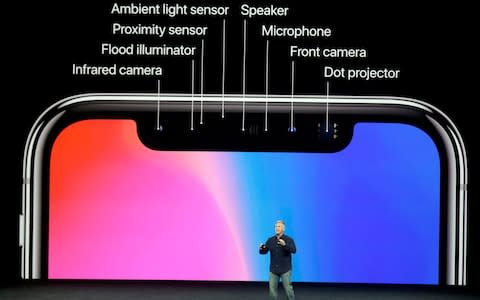How do the iPhone X and iPhone 8 compare?

While the £1,000 iPhone X has dominated the headlines, Apple also released its new iPhone 8 and 8 Plus smartphones on September 12.
These phones serve as mid-points between Apple's iPhone 7 and its new premium device, which has a different screen, design and no home button.
So how do the three new devices compare to one another? Here is a breakdown of the major stats and specs of the trio of devices.
Key info | Release dates and prices
Screen size and design
The three new iPhones actually have significantly different designs, despite the initial iterative appearance of the iPhone 8.
The iPhone X features a screen that covers almost the entire the front of the phone, making it the first iPhone with an edge-to-edge display. The screen is 5.8 inches, even larger than the one found on iPhone 8 Plus, which is 5.5 inches.

The iPhone 8 and 8 Plus have a general design that appears more similar to the older iPhone models. But like the iPhone X they have an all-glass body, which allows for wireless charging.
The iPhone X also features a notch at the top of its screen, which makes room for its front camera, speaker and infrared camera for facial recognition.
Both devices come in a limited colour range, with the iPhone X available in silver and space grey, and the iPhone 8 in silver, space grey and blush gold.

OLED display
Apple has put a lot of energy into building a superior screen for its iPhone X, which is one reason it is shipping so much later than the iPhone 8, according to reports. The new screen is Apple's most detailed on a smartphone.
The OLED display has a resolution of 2,436 x 1,125 pixels, or 458 pixels per inch (the Samsung Galaxy Note 8 actually has a greater pixel density), which allows the device to produce truer dark colours.
The iPhone 8 has a similar retina HD display to the iPhone 7, which won't be as clear as the iPhone X. But ,since it does not have the indent at the top of the screen, you get a fuller picture.
Key features | iPhone X
Processor speed
The iPhone X and iPhone 8 are both powered by Apple's own A11 Bionic processor. This makes both phones lightning fast and is said to enable smoother performance and greater battery life.
Face ID vs Touch ID
Apple's Face ID is what the company says will offer "one in a million" security, making it virtually impossible to hack your phone by normal means. Users look at their phone with their eyes open, then the phone will scan their face with infrared technology and unlock.
Not everyone is so excited about this, with some describing it as creepy. Critics have said the technology isn't that new (facial identification has appeared on several other smartphones), and others are reluctant to lose the fingerprint scanner. The iPhone 8 will keep Touch ID, meaning users will have to make the choice between the two security systems.
Augmented reality and animoji
One thing that the iPhone X will have that the iPhone 8 lacks is the ability to create animoji - new emoji that mirror owners' facial expressions. Thanks to its front camera and infrared scanner, the iPhone X can take a more detailed images and mimic expressions.
Animoji
This feature will also be coming to third party apps, such as Snapchat, so you can send more detailed masks and lenses than you can on the normal app.
Read more | iPhone X launch
Price
As Apple's premium model, the iPhone X costs significantly more than the iPhone 8. The record £999 price tag for the iPhone X has divided consumers. Some say it isn't too much to pay for a high-end device they will use every day, while others say they will be sticking with Android.
The iPhone 8 costs a more reasonable £699 for the 64GB version, which is £100 more than the entry level 32GB iPhone 7. Consumers interested in the iPhone 8 Plus will pay the slightly higher price of £799 for the 5.5-inch screen and dual-lens camera.
What about the iPhone 7?
The iPhone X is a significant step away from the iPhone 7. With wireless charging, a glass design and a full screen on the front of the phone, it is a radical departure.
The iPhone 8 is much more iterative upgrade than a whole new device. Yet it does keep many of the best features that made the iPhone 7 and iPhone 7 Plus. It has a super fast Touch ID and standard screen, but with a more powerful processor and better battery power packed in.
Verdict
For the extra £200, the iPhone X offers a more significant upgrade and packs innovative features such as the all-screen display and facial recognition technology, which could be worth it if you keep the phone for two years.
The iPhone 8 is highly iterative of the iPhone 7, but it has the bonus of Touch ID and a home button for those that love Apple's current technology.
If you have the money, the iPhone X offers the more exciting upgrade, while the iPhone 8 offers only modest improvements on the old device. Check back for a full review of the new products in the near future.
Ten years of iPhone development

 Yahoo Finance
Yahoo Finance 